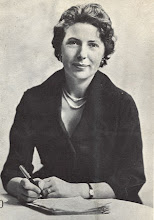 I finally read The Crystal Cave! For years I've meant to, and been slightly ashamed that I haven't before. I mean, I love Stewart so much that I've spent many, many hours creating a website about her, and I haven't read her most critically acclaimed novel? (We won't go into an argument now about why her suspense novels did not receive the literary attention her Arthurian books did.)
I finally read The Crystal Cave! For years I've meant to, and been slightly ashamed that I haven't before. I mean, I love Stewart so much that I've spent many, many hours creating a website about her, and I haven't read her most critically acclaimed novel? (We won't go into an argument now about why her suspense novels did not receive the literary attention her Arthurian books did.)What kept me from reading the book for so many years is the fact that it's about King Arthur. I know that story, and I know it doesn't end well. I have very little patience with tragedy. But I should have known that Stewart would still deliver an enjoyable tale. And actually we don't even get to meet Arthur in TCC--it is wholly Merlin's story.
The book opens when Merlin is six years old. He is the bastard son of the daughter of one of the lesser kings of England, in Wales in the 5th century. His mother kept his father's name an absolute secret, even from Merlin, and the rumor has started that he is the son of the devil or a demonic spirit. And we soon learn that Merlin does have a bit of magic about him: he has the Sight, which occasionally gives him visions. He is taught by a local wise man, not only about things mystical, but also about science and medicine.
When Merlin is twelve, his grandfather dies and his uncle comes to power. The already precarious political situation crumbles further. Merlin has always had some protection in the fact that as an illegitimate child his claim to the throne (something he has no interest in) has never been good. But his uncle sees him as a threat, so Merlin has to run for it. He goes to Brittany and joins Ambrosius, a Roman Briton who is preparing to invade England. Ambrosius takes Merlin in as a trusted advisor, and Merlin is instrumental in Ambrosius's successful campaign and his eventual crowning as the first King of all England.
If anyone is wondering where in all this is the Arthurian story you know, at the end of the book Merlin is advisor to Ambrosius's brother Uther, who fathers Arthur. TCC is the first book of a trilogy, followed by The Hollow Hills and The Last Enchantment. I'm assuming we see more of Arthur in those two.
I admit I have little experience with Arthurian stories, but this felt much more like historical fiction than fantasy to me. The historical detail is so interesting, and Stewart obviously spent a lot of effort on research. It's a time period I know very little about, after the Roman occupation when Briton and Saxon leaders were fighting it out. The Roman names are a bit confusing (esp. Vortigern and Vortimer--I couldn't keep them straight), but all the history is presented very clearly. It's all fascinating, and though complex, never overwhelming.
So while the history is realistic, the fantastical and mystical elements are still very present, though they are wrapped up discussions of the many religions of the time. Much like the political situation, religion too was a fragmented matter--a kind of smorgasbord of British druidism, Christianity, and the eastern cult of Mithras that the Romans adopted and brought to England. Merlin is very sure that his power comes from god--one god, a single power, whatever you call him--but he dabbles in whatever religious experience comes his way in order to learn all he can. Really interesting.
Merlin is a fascinating character. A bit of a loner, keenly intelligent and curious. TCC is a coming of age story more than anything else, and we see him develop his intelligence and his powers. And that is his total ambition; he has no dreams of ruling himself. He is self-effacing and humble, though his story is such a big one. One of my favorite lines in the book is when Ambrosius says to him: "No, Merlin, you will never make a king, or even a prince as the world sees it, but when you are grown I believe you will be such a man that, if a king had you beside him, he could rule the world."
I admit I was hoping for a bit of a love story tucked in somewhere, but Merlin is really almost asexual. Not that he doesn't feel the natural urges, but he suppresses them because he just knows that that type of relationship would interfere with his destiny, though that sounds overly grandiose. But his other relationships (with his mother, Ambrosius, teachers, and friends) made up for the lack of a traditional love story and served to personalize and warm up the story.
The style of this book is very different from Stewart's suspense novels, but one element that is the same is the vivid description of setting. It's one of the things she's most famous for and for good reason. And the language is simply beautiful.
Final thoughts: I still like Stewart's suspense novels better, though this has nothing to do with the quality of the books. They are just more my style--a love story satisfies me like little else. ;) But this was a great read. If I had any doubt, I would know it was good by the length of my review. The Crystal Cave gave me lots of talk about and lots to think about! I'll be reading The Hollow Hills soon.






